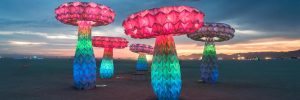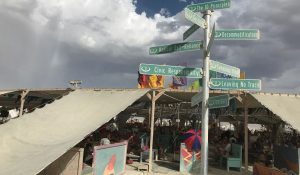25 Jun No Spectators: The Art of Burning Man at the Smithsonian

Art by: FoldHaus collective Photo Credit: Rene Smith
In This Article (Click on a section to quickly go to it)
No Spectators: The Art of Burning Man at the Smithsonian
There are no spectators this summer. Take a break from all the raving and bring some art fueled culture into your life. Washington D.C. offers free museums all throughout its city center, and down the street from the White House lies the Smithsonian’s Renwick Gallery. It is currently showcasing No Spectators featuring past Burning Man art installations.
The Burning Man Art
Each year, 70,000 people from around the world camp the harsh Nevada Black Rock Desert for a week. Once there, the thriving temporary city of Burning Man emerges. The desert city fosters creativity, innovation, and ingenuity based on its ten principles. The outcome is jaw-dropping pieces of art. Now those installations intended for the desert take up entire rooms in the Renwick Gallery.
The carefully curated exhibit includes original costumes, jewelry, relics, and a few of the mutant vehicles. Photographs of the famed Playa decorate the walls. Also, materials borrowed from the Nevada Museum of Art’s 2017 show, City of Dust: The Evolution of Burning Man, will be on display. That exhibit within an exhibit touches on the history and growth of the Burning Man.
The Temple
Notable for residing away from the festival’s loud and unruly environment. Each year the temple is built for meditation and reflection. Traditionally, festival-goers leave offerings that range from scribbled poetry to the ashes of loved ones. The Temple, with all its offerings, is burned as the closing ritual. The Temple for No Spectators was specifically created for the museum’s Grand Salon and was designed by artist David Best. David, a 73-year-old sculptor, has created nine temples for the festival since he first initiated the tradition in 2000. Guests visiting Renwick are encouraged to leave offerings.
Truth is Beauty
An 18-foot replica of artist Marco Cochrane’s steel mesh sculpture of a woman fearlessly stretching to the sky. The artist poses the question, “What would it look like if women were safe?” The 55-foot original debuted at Burning Man in 2013 and resides on the San Leandro Tech Campus in California. Special lighting effects for the Renwick’s smaller version creates a life-like movement that complements the woman’s dancer-like pose.
Shrumen Lumen
A testament to the unique technology used in the art of Burning Man. The festival is at the forefront of a new artistic movement that combines art, lights, and computer programming. The Shrumen Lumen by the art collective, FoldHaus, is a colorful, interactive constellation of gigantic LED mushrooms. They first graced the Playa in 2016, and in its original form, it takes over an entire gallery! As you walk through, it urges your participation. Visitors stand on a glowing foot panel and, like magic, watch the shroom grow!
Beyond the Renwick Gallery walls, nearby neighborhoods add to the adventure. Many installations are on display such as the 12-foot steel XOXO letters. A concrete bust of Maya Angelou resting on three books (which viewers can actually enter) is here. Lastly, a penny-coated bear on his hind legs is also on display.
Nora Atkinson curated the amazing exhibition. Collaborators included the Burning Man Project, the nonprofit organization responsible for producing the actual event, and The Burning Man community groups. They were instrumental in suggesting artworks for inclusion in the exhibition. Two of the ten principles are radical participation and inclusivity. These, in addition to a long-standing saying on the Playa, “No Spectators,” was the inspiration for the exhibit’s name.
No Spectators, So Get Up & Go
No Spectators: The Art of Burning Man and the installations stationed in the surrounding neighborhoods will be available to view at the Smithsonian American Art Museum’s Renwick Gallery. This is located at Pennsylvania Avenue and 17th Street in Washington, D.C. until January 21, 2019. The museum is open daily between 10:00 a.m.–5:30 p.m and it’s FREE! Click here for more information.




No Comments